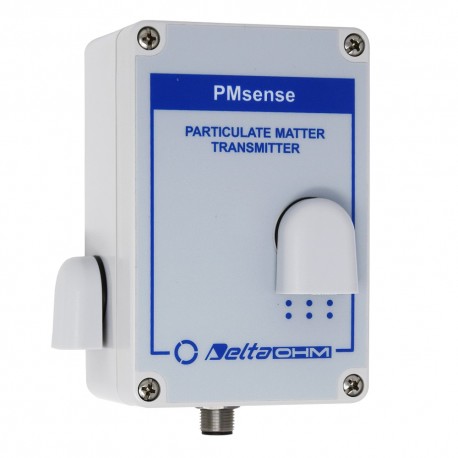No products
Prices are tax excluded
Product successfully added to your shopping cart
There are 0 items in your cart. There is 1 item in your cart.
Particulate Matter Transmitter - PMsense
New
- Meausurement of the exact content of PM1.0, PM2.5 and PM10.
- Stand-alone unit, easy to integrate in Automatic Weather Stations.
- Easy Cloud Connection.
- More info about this product.
- Remove this product from my favorite's list.
- Add this product to my list of favorites.
| Type of Instrument | Air Quality Analyzer |
| The Sensor measures: | Particles |
The PMsense is a PM1.0, PM2.5 and PM10 Particulate Matter transmitter with RS485 Modbus-RTU output that is suitable for outdoor air quality monitoring.
The concentration of dust particles is measured using a laser scattering principle.
The transmitter is maintenance-free and has fast response, high sensitivity and an excellent stability.
The PM sensor can be operated in two manners:
- Continuous operating mode: the sensor is always active and measurements are continuously taken. In this mode at least 10,000 hours of PM sensor life are guaranteed.
- Discontinuous operating mode (default): the sensor is activated at regular intervals, when measurements has to be taken. This mode increases the PM sensor life.
On request there is an optional CO2 sensor that can be integrated in the trasmitter.
The transmitter may be supplied with up to 2 optional configurable 4…20 mA, 0…5 V or 0…10 V analog outputs.
More background information on why to measure Particulate Matter (PM) can be found here.
.jpg)
Delta OHM presents a logger with PM measurement. But why would you want to measure PM? What is PM10 or P2.5 or PM1.0; Why should it be measured? In this article we try to answer some questions.
Particulate Matter (PM), also called particulate pollution.
An explanation of the term PM, as found on the EPA (United States Environmental Protection Agency) site: the term for a mixture of solid particles and liquid droplets found in the air. Some particles, such as dust, dirt, soot, or smoke, are large enough or dark enough to be seen with the naked eye. Others are so small that they can only be detected with an electron microscope.
What does the number behind PM mean?
The number represents the size of the particle, expressed in micrometers.
So: PM1.0 means the collection of measured particles having a diameter of 1 µm or less. Talking about PM10 means that we take into consideration all particles with a size of 10 µm or less.
Why is it interesting to know the PM:
The particles we are talking about are so small that we (can) inhale them without realizing it. But the effect of inhaling them can have dramatic consequences. Especially particles smaller than PM2.5 are considered dangerous to human health; they can get deep into your lungs or they can even get into your bloodstream.
Where does this contamination come from?
Some of the particles are formed by human interaction, others are the result of spontaneous reactions of chemicals found in the atmosphere. Those that are being emitted as a result of human interaction can be found in areas with high industrial activity, fires, smoke, construction sites, or in areas with high automobile and transportation activity.
Particulate contamination:
The data logger introduced by Delta OHM measures the quality of the air inside buildings. Delta Ohm will also introduce an outdoor version to be combined with our AWS (Automatic Weather Station). Buildings that are likely to face air quality problems are e.g. those near heavy traffic situations in cities or highway areas. Or as another example, offices connected to industrial workplaces in steel mills, cement factories, or other production areas.
To be clear:
Measuring air quality is very important when we care about health. Depending on the measure, we can take temporary measures (ventilation or even work on other points) or we can use it to improve air conditioning and filtering.
Interested? Take a look at the specifications of the HD50PM: very simple to install (power and a WiFi network or cables are enough). It can be used with cloud storage, on a network of loggers, or as a stand-alone unit. Or just ask us for more information.
PMsenseCR:
► Particulate Matter transmitter for monitoring clean room and controlled atmos-phere environments as required by the ISO 14644 standard.
► The dust particles concentration is measured using the laser scattering principle.
► Detection of particles of size: > 0.3 μm ; > 0.5 μm ; > 1 μm ; > 2.5 μm ; > 5 μm.
► The transmitter has a digital RS485 output with MODBUS-RTU or ASCII propri-etary protocol.
► A version with two additional 0/4…20 mA (0…10 V on request when ordering) analog outputs is available.
► An optional CO2 sensor can be integrated in the transmitter.
► PM measuring range: < 5 x 107 pcs/m3
► CO2 measuring range: 0…5000 ppm.
► Operating conditions: -20…+70 °C / 0…95 %RH / 500…1500 hPa
► Power supply: 7…30 Vdc (15…30 Vdc for 0…10 V analog outputs)
► CPM12-8PM… optional cable with M12 connector.
.jpg)
.jpg)





